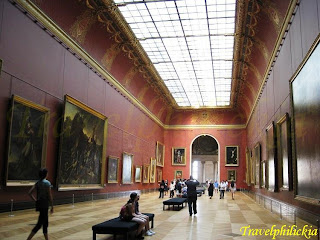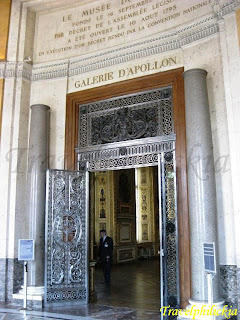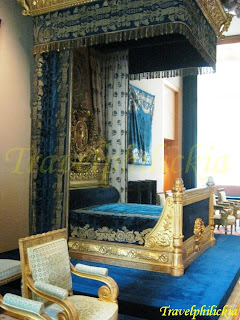Being Singaporeans, my colleagues and I bought our admission tickets two days ahead of our actual visit. On the day, we woke up early and reached the Louvre Museum at about 8.50 am, which was 10-mins before its opening hours.
Musée du Louvre
The Louvre Museum, or Musée du Louvre in French, is known to be one of three great museums in Europe (and probably the whole world). The other two great museums are British Museum in London and Vatican Museums in Rome. The Louvre Museum (left photo below) now houses more than 35,000 objects.
First constructed as a fortress in 1190 by King Philippe-Auguste to protect Paris against Vikings raids, it lost its imposing keep in the reign of François I, who replaced it with a Renaissance-style building (right photo below). Thereafter four centuries of French Kings and Emperors improved and enlarged it.


The most recent addition is a glass pyramid (photos below) in the main courtyard from which all galleries can be reached. This popular new main entrance was designed by American Chinese architect 'I.M. Pei' (貝聿銘). The pyramid and its underground lobby were inaugurated on 15 October 1988. To me, the glass pyramid added some contemporary elements to the museum.


Among the many exhibits, three objects are most well-liked by visitors; namely Mona Lisa, Winged Victory of Samothrace and Venus de Milo.
Mona Lisa
- Painted by Leonardo da Vinci in circa 1503–1519, this is a small portrait of Florentine noblewoman known as La Gioconda. The portrait's engaging smile has prompted endless commentary ever since (left photo below). The image is widely recognized and sought out by visitors to the Louvre. It is considered the most famous painting in the world.
Immediately after the museum has opened we rushed up to the Salle des Etats (Denon Wing) to see this famous painting. Within 10-mins after we've arrived, the area was swarmed with many visitors (right photo below).


Winged Victory of Samothrace
- Also known as the Nike of Samothrace, it is a marble sculpture of the Greek Goddess Nike (Victory). Since 1884, it has been prominently displayed at the Louvre and is one of the most celebrated sculptures in the world (left photo below). Despite its significant damage and incompleteness, the Victory is held to be one of the great surviving masterpieces of sculpture from the Hellenistic period (late 3rd to 2nd century BC). The sculpture is located at the daru staircase where it is often crowded with visitors (right photo below).


Venus de Milo
- Also known as Aphrodite of Milos, it is an ancient Greek statue depicting Aphrodite (Venus to the Romans) the Greek goddess of love and beauty. Found in 1820 on the island of Milos in Greece, this statue is the ideal feminine beauty which was made in the Hellenistic period (left photo below). From the congested exhibition area, there is no reason to doubt how popular this statue is (right photo below).


French Paintings
- After visiting the 'Mona Lisa' gallery, we walked up to the French paintings gallery (left photo below). There are portraits of various painters from mid 13th to 19th century (right photo below) painted on the ceiling. So do look up to the top when visiting this gallery.


The red wall gallery exhibits many large-format French paintings (left photo below). Among these large paintings, the more renowned is The Raft of the Medusa (right photo below) painted by Théodore Géricault in 1819. Measuring 4.91-meters by 7.16 meters, the painting depicts a moment from the aftermath of the wreck of the French naval frigate Méduse where 15 passengers were set adrift on a hurriedly constructed raft. The Raft of the Medusa portrays the moment when, after 13 days adrift on the raft, the remaining 15 survivors view a ship approaching from a distance.


Galerie d'Apollon
- The Galerie d'Apollon is situated above the Petite Galerie. The original room was destroyed by a fire in 1661 but was rebuilt later. The ceiling is homage to the Sun King, Louis XIV. The gallery was recently restored to its former glory (photos below).




Napoleon III Apartments
- Napoleon III reopened the Louvre in 18th century and boasted a number of sumptuous reception halls. Those of the Palais des Tuileries have unfortunately been lost. However, the rooms in the Ministry of State, opened in 1861 in the Aile Richelieu, have retained their decor of gold, stuccos, marble, bronze, silk and velvet. They also feature ornate painted ceilings (photos below).




One interesting exhibition I saw was the King's bedroom where furniture from the bedroom of Louis XVIII were displayed. One question that most visitors had was why the bed seems to be shorter compared to modern ones? Perhaps it's the height of the King that explained all (photos below).


Several treasures from the former court were also on display, including the ivory products (photos below).


Running parallel to the small rooms, the entrance gallery leads to the large hall, the small dining room, and the large dining hall. The large drawing room of the Napoleon III Apartments typifies the taste of the period for opulent interiors (photos below).






Café Richelieu
- As we were tired from walking the huge areas in the museum, we decided to have our break inside Café Richelieu (left photo below). The Café Richelieu can seat 60 guests for dinner and accommodate up to 150 guests for breakfast or cocktails (right photo below).


The prestigious setting in the café is further enhanced by a splendid view of the Louvre Pyramid and a terrace overlooking the Court Napoléon (photo below).
We ordered some cakes to share and I got myself a cup of earl grey tea (photos below). The taste was good and total cost for each person was EUR 8; definitely worth the price for the food and the view.




Egyptian Antiquities
- The Department of Egyptian Antiquities comprising over 50,000 pieces, including artifacts from the Nile civilizations which date from 4,000 BC to the 4th century. Guarded by the Large Sphinx (ca. 2000 BC), the collection is housed in more than 20 rooms. Holdings include art, papyrus scrolls, mummies, tools, clothing, jewelry, games, musical instruments, and weapons (photos below).






One important example of ancient Egyptian art is the sculpture of Seated Scribe (left photo below). The sculpture was discovered at Saqqara in 1850 and dated to the period of the 4th Dynasty, 2620 –2500 BC.
There are also many Egyptian sarcophagus exhibited (right photo below and bottom photos). These relics are comparable to those in British Museum in terms of numbers and varieties.




Near Eastern Antiquities
- Another interesting collection is the Department of Near Eastern Antiquities (left photo below). The colored glazed terracotta bricks with an image of a lion (right photo below) is one of the highlights exhibited in this department.


Italian Sculptures
- The hall of Italian Sculptures contains many famous sculptures made by Italian artists (left photo below). Among them, the most renowned is the dying slave (right photo below) created by Michelangelo between 1513 to 1516 that was meant to serve the tomb of Pope Julius II in Rome.


There are several rules within Louvre museum such as forbidden to use flash lights during photography (left photo below) and prohibit to speak loudly (right photo below). All these signs have been creatively incorporated into the image of some familiar paintings.


The admission cost was EUR 9.50. The nearest metro station is Palais Royal or Musée du Louvre station. Opening hours from 0900 hours to 1800 hours daily. Admission is free on first sunday of the month.
Arc de Triomphe du Carrousel
The Arc de Triomphe du Carrousel (left photo below) is a triumphal arch located in the Place du Carrousel on the site of the former Tuileries Palace, now Louvre Museum. It was built between 1806 and 1808 to commemorate Napoleon's military victories of the previous year. The quadriga on top of the arch (right photo below) is a copy of the so-called Horses of Saint Mark that adorn the top of the main door of the St Mark's Basilica in Venice.


Restaurants du Monde
We decided to have our lunch inside this restaurant du Monde (left photo below). In fact it is a food court which is located underneath the Louvre inside a mall. This food court has Mediterranean, Asian, Italian, Spanish and French cuisine to choose from. There's even separate McDonalds Restaurant and McCafe with drinks and pastries.
Ordered a set meal of salmon with fries and drinks (right photo below) for myself that cost EUR 13.90. Taste was acceptable and the food was plenty that I couldn't even finish the chocolate pie.


Notre-Dame de Paris
No other building is more associated with the history of Paris than Notre-Dame de Paris (photos below). It stands majestically on the ile de la cité, cradle of the city. Pope Alexander III laid the first stone in 1163, marking the start of 170 years of toil by armies of Gothic architects and medieval craftsmen. Ever since, famous processions had passed through the three main doors below the massive towers.


The cathedral is a Gothic masterpiece standing on the site of a Roman temple. At the time it was finished, in about 1330, it was 130-meters long and featured flying buttresses, a large transpet, a deep choir and 69-meters high towers. Perhaps it is the legendary novel, The Hunchback of Notre Dame, by Victor Hugo that makes this cathedral even more famous.
The West Rose window depicts the Virgin in a medallion of rich red and blues (left photo below). The King's Gallery below the window features 28 Kings of Judah gazing down on the crowds (right photo below).


The cathedral's legendary gargoyles or chimères, hide behind on a large upper gallery between the towers (left photo below). The portal of Virgin, surrounded by saints and kings, is a fine composition of 13th century statues (right photo below). The saints formed the decoration of the main doors (bottom photos).




From the main entrance, the view takes in the high-vaulted central nave looking down towards the huge transept, the choir and the high altar (photos below).


The chancel screen is a 14th century high stone screen enclosed the chancel and provided canons at prayer with peace and solitude from noisy congregations (left photo below). A model of the building was exhibited (right photo below) together with the history of the cathedral.


The South Rose Window (left photo below) is located at the south end of the transept. This window retains some of its original 13th century stained glass. The window depicts Christ in the centre, surrounded by virgins, saints and the 12 Apostles. Other stained glass windows within the cathedral are also equally impressive (right photo below).


The nearest metro station is Cité or Saint-Michel station of Line 4, and opening hours from 0800 hours to 1845 hours (or till 1915 hours on Saturdays and Sundays).
After our visit, my colleague and I then took the train from Gare de Lyon at 1758 hours to Neuchâtel. Along the train journey in France, fascinating scenes were seen; such as the thick fog among the dense forest (left photo below) and the magnificent castle situated high on the hills (right photo below).


After a long train ride, we reached Neuchâtel at 2147 hours. With this, it ended my first part of visit to Paris.
 Posts RSS
Posts RSS



